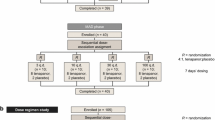Abstract
Objective: To evaluate the bioavailability, cardiac safety and tolerability of desloratadine when given in combination with the CYP3A4 inhibitor erythromycin.
Design: A randomised, 2-way crossover, placebo-controlled, third party-blind, multiple dose study.
Participants: 24 healthy volunteers (12 men, 12 women) aged 19 to 46 years.
Interventions: Oral desloratadine 7.5mg daily in combination with either placebo (n = 24) or erythromycin 500mg every 8 hours (n = 24) for 10 days. After a minimum 7-day washout period, participants crossed over to the alternative regimen.
Main outcome measures: ECG parameters.
Results: Desloratadine/erythromycin did not induce clinically or statistically significant changes in any ECG parameter. The maximum corrected QT (QTC) interval was 445 msec for both treatments. The peak plasma concentration and area under the plasma concentration-time curve from 0 to 24 hours of desloratadine were slightly increased by 1.2- and 1.1-fold by concomitant administration of erythromycin compared with desloratadine/placebo. Gastrointestinal adverse events were more frequent after desloratadine/erythromycin than desloratadine/placebo (46 s 4%), reflecting the poor gastrointestinal tolerability of erythromycin. There were no reports of syncope.
Conclusion: Combined desloratadine/erythromycin therapy was well tolerated and had no clinically relevant electrocardiographic effects at a dose that was 50% higher than the recommended dose of 5mg. Although coadministration of erythromycin slightly increased plasma concentrations of desloratadine, this change did not correlate with any prolongation of the QTC interval, and no toxicity was observed clinically.



Similar content being viewed by others
References
DuBuske LM. Second-generation antihistamines: the risk of ventricular arrhythmias. Clin Ther 1999; 21: 281–95
Ducic I, Ko CM, Shuba Y, et al. Comparative effects of loratadine and terfenadine on cardiac K+ channels. J Cardiovasc Pharmacol 1997; 30: 42–54
Zhou Z, Vorperian VR, Gong Q, et al. Block of HERG potassium channels by the antihistamine astemizole and its metabolites desmethylastemizole and norastemizole. J Cardiovasc Electrophysiol 1999; 10: 836–43
Suessebrich H, Waldegger S, Lang F, et al. Blockade of HERG channels expressed in Xenopus oocytes by the histamine receptor antagonists terfenadine and astemizole. FEBS Letters 1996; 385: 77–80
Yap YG, Camm AJ. The current cardiac safety situation with antihistamines. Clin Exp Allergy 1999; 29 Suppl. 1: 15–24
Yap YG, Camm AJ. Arrhythmogenic mechanisms of non-sedating antihistamines. Clin Exp Allergy 1999; 29 Suppl. 3: 174–81
Paris DG, Parente TF, Bruschetta HR, et al. Torsades de pointes induced by erythromycin and terfenadine. Am J Emerg Med 1994; 12: 636–8
Honig PK, Woosley RL, Zamani K, et al. Changes in the pharmacokinetics and electrocardiographic pharmacodynamics of terfenadine with concomitant administration of erythromycin. Clin Pharmacol Ther 1992; 52: 231–8
Kreutner W, Hey JA, Anthes J, et al. Preclinical pharmacology of desloratadine, a selective and nonsedating histamine H1 receptor antagonist: 1st communication: receptor selectivity, antihistaminic activity, and antiallergenic affects. Arzneimittelforschung 2000; 50: 345–52
Meltzer EO, Premier BM, Nayak A. Efficacy and tolerability of once-daily 5mg desloratadine, an H1-receptor antagonist, in patients with seasonal allergic rhinitis. Assessment during the spring and fall allergy seasons. Clin Drug Invest 2001; 21(1): 25–32
Schuirmann DJ. A comparison of the two one-sided test procedure and the power approach for assessing the bioequivalence of average bioavailability. J Pharmacokinet Biopharm 1987; 15: 657–80
Acknowledgements
Supported by a research grant from Schering-Plough Research Institute, Kenilworth, New Jersey.
Author information
Authors and Affiliations
Rights and permissions
About this article
Cite this article
Banfield, C., Hunt, T., Reyderman, L. et al. Lack of Clinically Relevant Interaction Between Desloratadine and Erythromycin. Clin Pharmacokinet 41 (Suppl 1), 29–35 (2002). https://doi.org/10.2165/00003088-200241001-00005
Published:
Issue Date:
DOI: https://doi.org/10.2165/00003088-200241001-00005




